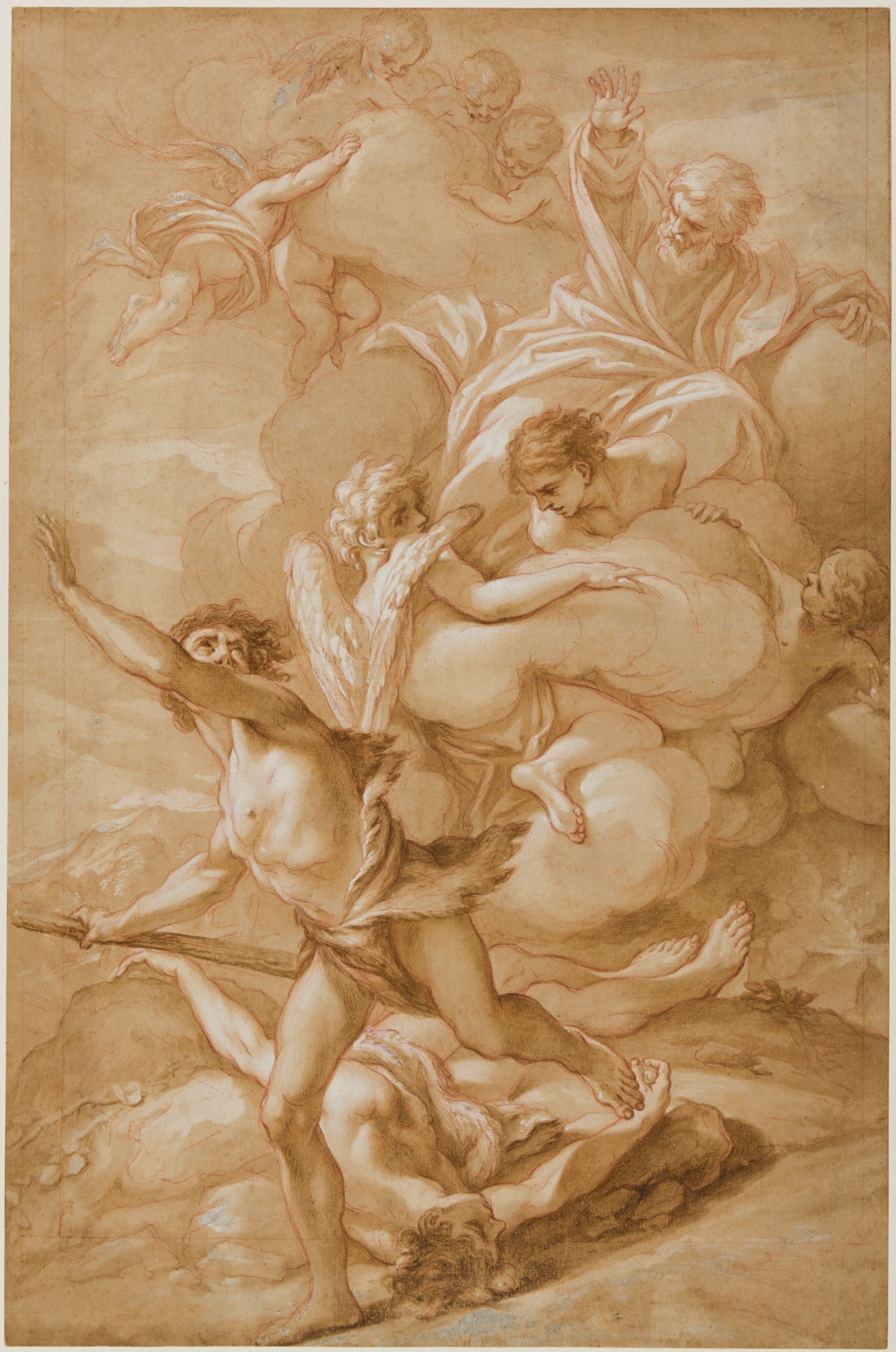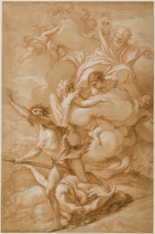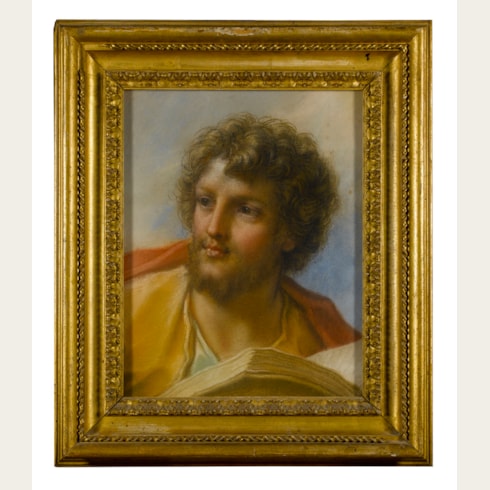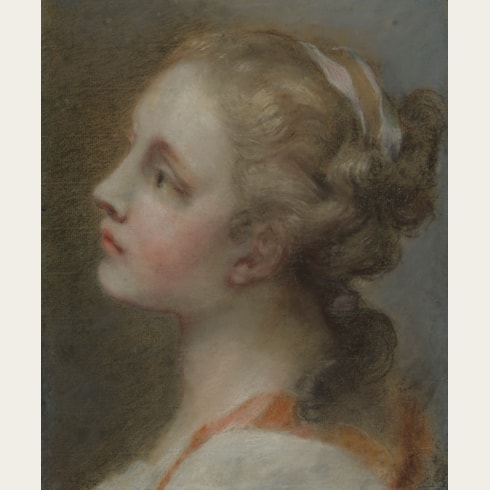Benedetto LUTI
(Florence 1666 - Rome 1724)
God Cursing Cain after the Murder of Abel
Sold
Red and black chalk and brown wash, extensively heightened with white, on buff paper.
Partly squared for transfer in red chalk.
501 x 330 mm. (19 3/4 x 13 in.)
Partly squared for transfer in red chalk.
501 x 330 mm. (19 3/4 x 13 in.)
This large drawing is a finished compositional study for Benedetto Luti’s monumental early painting of God Cursing Cain after the Murder of Abel, today in the collection of Viscount Scarsdale at Kedleston Hall in Derbyshire. This was the artist’s first painting completed after his arrival in Rome in 1691, and seems to have been executed for a competition at the Accademia di San Luca. The huge canvas of God Cursing Cain after the Murder of Abel is mentioned in letters written by Luti to his teacher Gabbiani in September and December 1692, in which he notes that the painting had been exhibited in August, for the Feast of Saint Bartholomew, in the Roman church of San Bartolomeo dei Bergamaschi. Luti then sent the painting to his patron in Florence, the collector Giovanni Nicolò Berzighelli, who presumably also acquired its pendant of The Feast in the House of Simon, also now at Kedleston Hall, either in 1692 or shortly thereafter. The composition of God Cursing Cain proved to be very popular, and was copied several times, and there also exists an engraving after the painting, with the image reversed.
Both paintings by Luti were purchased at the posthumous sale of Berzighelli’s collection in 1724 by the Anglo-Florentine painter, dealer and collector Ignazio Hugford. In his account of Luti’s life and career published in his Raccolta di cento pensieri diversi di Anton Domenico Gabbiani in 1762, Hugford praises the two paintings as among Luti’s best works, and adds that they were later sold to an English collector. This must have been after 1746, when the two paintings were engraved for Hugford by the Venetian printmaker Giuseppe Wagner from copy drawings provided by Giovanni Battista Cipriani. (Hugford later used the prints to try and sell the paintings, for 3,000 lire, to the picture gallery of the Electors of Saxony in Dresden in 1754, without success.) By 1757 Luti’s two paintings are recorded in the collection of Nathaniel Curzon, 1st Baron Scarsdale, at Kedleston Hall. The paintings were originally intended to be hung high on the wall on either side of a niche in the Dining Room at Kedleston, but were soon moved by Robert Adam to the large Drawing Room, where they remain today.
The present sheet is the only drawing by Luti that may be persuasively regarded as a preparatory study for the painting of God Cursing Cain after the Murder of Abel. An outline drawing in black chalk, formerly in the collection of the Vicomte Villain XIII and recently on the art market in Paris, shows several differences with the final painting, and has been regarded as a study for it. However, that drawing is incised for transfer and rubbed with red chalk on the verso, and as such may have been preparatory for a reproductive engraving rather than the painting itself.
Other drawings related to the Kedleston Hall painting may be dismissed as later copies of the painting or the engraving. These include a red chalk drawing in the museum of the Rhode Island School of Design in Providence and a pen and wash study in the Biblioteca Reale in Turin, as well as a drawing in black chalk on blue paper in the Statens Museum for Kunst in Copenhagen and a brush and wash drawing in the National Gallery of Scotland in Edinburgh. A reversed drawing of this composition is also recorded in a collection in Bassano del Grappa.
Both paintings by Luti were purchased at the posthumous sale of Berzighelli’s collection in 1724 by the Anglo-Florentine painter, dealer and collector Ignazio Hugford. In his account of Luti’s life and career published in his Raccolta di cento pensieri diversi di Anton Domenico Gabbiani in 1762, Hugford praises the two paintings as among Luti’s best works, and adds that they were later sold to an English collector. This must have been after 1746, when the two paintings were engraved for Hugford by the Venetian printmaker Giuseppe Wagner from copy drawings provided by Giovanni Battista Cipriani. (Hugford later used the prints to try and sell the paintings, for 3,000 lire, to the picture gallery of the Electors of Saxony in Dresden in 1754, without success.) By 1757 Luti’s two paintings are recorded in the collection of Nathaniel Curzon, 1st Baron Scarsdale, at Kedleston Hall. The paintings were originally intended to be hung high on the wall on either side of a niche in the Dining Room at Kedleston, but were soon moved by Robert Adam to the large Drawing Room, where they remain today.
The present sheet is the only drawing by Luti that may be persuasively regarded as a preparatory study for the painting of God Cursing Cain after the Murder of Abel. An outline drawing in black chalk, formerly in the collection of the Vicomte Villain XIII and recently on the art market in Paris, shows several differences with the final painting, and has been regarded as a study for it. However, that drawing is incised for transfer and rubbed with red chalk on the verso, and as such may have been preparatory for a reproductive engraving rather than the painting itself.
Other drawings related to the Kedleston Hall painting may be dismissed as later copies of the painting or the engraving. These include a red chalk drawing in the museum of the Rhode Island School of Design in Providence and a pen and wash study in the Biblioteca Reale in Turin, as well as a drawing in black chalk on blue paper in the Statens Museum for Kunst in Copenhagen and a brush and wash drawing in the National Gallery of Scotland in Edinburgh. A reversed drawing of this composition is also recorded in a collection in Bassano del Grappa.
Benedetto Luti was a pupil of Anton Domenico Gabbiani in Florence in the 1680s, and at the end of the decade was sent to Rome to complete his training at the Medici academy there. Admitted to the Accademia di San Luca in 1695, Luti worked in Rome for the remainder of his successful career, becoming one of the most important and influential artists in the city. He earned commissions from Popes Innocent XII and Clement XI and several cardinals, as well as members of the Roman nobility and the city’s leading families, and painted altarpieces and decorations for churches and palaces in Rome and elsewhere. Luti continued to maintain close contacts with Florence, however, and enjoyed the particular patronage of Cosimo III, Grand Duke of Tuscany; he also sold paintings to prominent collectors in France, England and Germany, notably Lothar Franz von Schönborn, Archbishop-Elector of Mainz. The 17th century biographer Lione Pascoli wrote of Luti that ‘he achieved a tender and delicate manner, of lovely and soft colour with perfect design, and with such harmonious compositions so well attuned to his exquisite taste, that no one has been able to imitate it.’
Luti was not a prolific painter, however, and less than eighty paintings by the artist are known today. A gifted teacher with a large studio, he counted among his pupils Placido Costanzi, Giovanni Paolo Pannini and the brothers Jean-Baptiste and Carle van Loo. He held private classes in life drawing and took a leading role in the affairs of the Accademia di San Luca, of which he was elected principe in 1720. Recognized as a fine connoisseur himself, Luti was also active as an art dealer, agent and collector in Rome, eventually assembling a large collection of drawings by earlier artists, numbering almost 15,000 sheets.
Benedetto Luti’s significance as a painter and draughtsman was aptly summarized by the pioneering modern scholar of 18th century Italian art, Anthony Clark: ‘Luti was a lovely and careful artist; and he is rather a rare one. His originality was appreciated, but not without reservations and misunderstanding. Highly intelligent, solitary, melancholy, and sickly, Luti was a great collector of drawings and prints, and not overfond of the act of painting – at which he was more brilliant and easy than any Roman colleague of the day. His honors and fame in Europe were considerable…His perfectly executed paintings, his drawings of exquisite quality…are one of the finest and most formative achievements of the century.’ As a draughtsman, Luti was particularly noted by his contemporaries for his work in pastel and coloured chalks, and beginning in the early years of the 18th century he produced a number of highly finished and coloured drawings of heads that were much sought-after by collectors and connoisseurs.
Luti was not a prolific painter, however, and less than eighty paintings by the artist are known today. A gifted teacher with a large studio, he counted among his pupils Placido Costanzi, Giovanni Paolo Pannini and the brothers Jean-Baptiste and Carle van Loo. He held private classes in life drawing and took a leading role in the affairs of the Accademia di San Luca, of which he was elected principe in 1720. Recognized as a fine connoisseur himself, Luti was also active as an art dealer, agent and collector in Rome, eventually assembling a large collection of drawings by earlier artists, numbering almost 15,000 sheets.
Benedetto Luti’s significance as a painter and draughtsman was aptly summarized by the pioneering modern scholar of 18th century Italian art, Anthony Clark: ‘Luti was a lovely and careful artist; and he is rather a rare one. His originality was appreciated, but not without reservations and misunderstanding. Highly intelligent, solitary, melancholy, and sickly, Luti was a great collector of drawings and prints, and not overfond of the act of painting – at which he was more brilliant and easy than any Roman colleague of the day. His honors and fame in Europe were considerable…His perfectly executed paintings, his drawings of exquisite quality…are one of the finest and most formative achievements of the century.’ As a draughtsman, Luti was particularly noted by his contemporaries for his work in pastel and coloured chalks, and beginning in the early years of the 18th century he produced a number of highly finished and coloured drawings of heads that were much sought-after by collectors and connoisseurs.
Provenance
Anonymous sale, Paris, Hôtel Drouot [Piasa], 23 March 2001, lot 33
Flavia Ormond, London, in 2002
Private collection.
Flavia Ormond, London, in 2002
Private collection.
Literature
Rodolfo Maffeis, Benedetto Luti: L’ultimo maestro, Florence, 2012, pp.222-224, under no.I.6, illustrated p.223 (as location unknown, ‘autografia incerta’); Ursula Verena Fischer Pace, Italian Drawings in the Department of Prints and Drawings, Statens Museum for Kunst: Roman Drawings before 1800, Copenhagen, 2014, p.172, under no.105.
Exhibition
New York, Flavia Ormond Fine Arts at Adelson Galleries, Master Drawings 1500-1895, 2002, no.7; Boston, Museum of Fine Arts, Splendor and Elegance: European Decorative Arts and Drawings from the Horace Wood Brock Collection, 2009, no.128.







